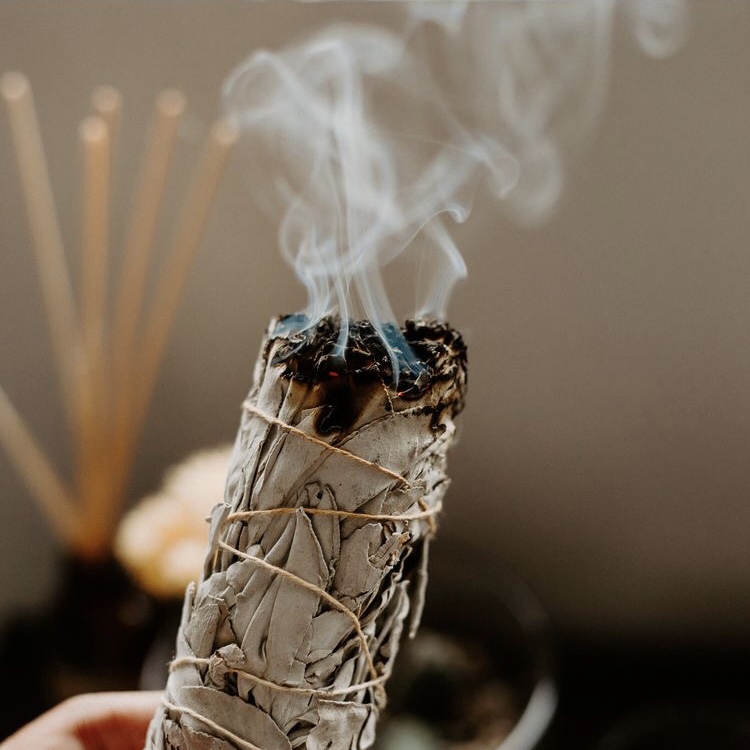
Introduction
Have you ever walked into a room and felt heavy, stagnant energy? Or experienced moments where your mind felt cluttered, and you needed a fresh start? Sage smudging is an ancient practice used for centuries to clear negative energy, purify spaces, and restore balance. Burning Sage also known as smudging is an ancient spiritual ritual. Smudging has been well established as a traditional Native American practice which many healers use to offer blessings and purify people, places and objects. Although cedar, lavender and sweet grass are often used during smudging ceremonies for their ability to uplift, purify, and bring positivity into a space, the most common herb used is sage. Smudging has long been used to connect to the spiritual realm or enchanted intuition.
Regardless of where you are on the spiritual path, if you’re in contact with any part of our materialistic world, you are bound to attract or experience negativity in some form, After all, opposites attract, like the moths to a flame.
For healers and laypeople in traditional cultures, burning sage is used to achieve a healing state or to solve or reflect upon spiritual dilemmas.
When you want to clear out the energy of a particular room, burning a sage smudging stick is an easy and effective way to do it. You can say an affirmation while rotating the sage stick to encourage peace, love, and happiness to fill the space.
Fortunately, you don’t have to be a shaman to use sage. We use it regularly as an essential spiritual tool to compliment our meditation practice and protect our energy fields.
- At RA TRIBE, we provide high-quality sage bundles and smudging tools to help you harness the power of this sacred ritual. In this guide, you’ll learn:
- What sage smudging is and why it’s effective
- How to properly smudge your home, aura, or crystals
- The best types of sage for energy cleansing
Let’s dive into the world of sage smudging!
⸻
- What Is Sage Smudging & Why Is It Powerful?
Sage smudging is a spiritual cleansing practice where dried sage leaves are burned to release smoke, which is believed to remove negative energy, cleanse auras, and invite positivity.
Benefits of Smudging
Clears negative or stagnant energy from your space
Enhances mental clarity and emotional balance
Creates a protective shield against bad vibes
Improves the energy flow in your home, workplace, or spiritual tools
Many cultures, including Native American, African, and Eastern traditions, have used smoke cleansing for centuries in rituals, meditation, and energy work.
- The Best Types of Sage for Cleansing
Not all sage is the same! Depending on your intention, you can use different types of smudging herbs:
White Sage – The most popular for purifying spaces and removing negative energy.
Blue Sage – Milder than White Sage, great for calmness and spiritual protection.
Palo Santo (Holy Wood) – Not sage, but a great alternative for raising vibrations and inviting positivity.
Lavender Sage – A mix of lavender and sage, ideal for relaxation and emotional healing.
At RA TRIBE, we offer ethically sourced White Sage bundles and Palo Santo sticks to help you cleanse and uplift your space.
⸻
- How to Smudge Your Space & Aura (Step-by-Step Guide)
What You Need:
- A sage bundle or Palo Santo stick
- A fireproof bowl (like an abalone shell) to catch ashes
- A lighter or matches
- An open window for ventilation
Step-by-Step Smudging Ritual
Set Your Intention – Before lighting the sage, take a deep breath and set your purpose (e.g., “I cleanse this space of all negativity and invite peace and harmony”).
Light the Sage Bundle – Hold the sage at a 45-degree angle, light the tip, and let it burn for 20-30 seconds before gently blowing out the flame. It should release smoke, not a strong flame.
Walk Around Your Space – Move the sage in a circular or waving motion, starting from the front door and moving clockwise through each room. Pay extra attention to corners, mirrors, and high-traffic areas.
Cleanse Yourself – To cleanse your aura, guide the smoke around your body, from head to toe, while visualizing negativity leaving your energy field.
Extinguish Safely – Once done, press the smudge stick into the fireproof bowl to safely extinguish it. Do not use water, as it may ruin the sage for future use.
Close the Ritual – Open a window or door to let the negative energy leave, and say a closing affirmation, such as “This space is now cleansed and filled with positive energy.”
⸻
- When & How Often Should You Smudge?
You can smudge as often as needed, but here are some key times when it’s most effective:
- After an argument or stressful situation
- Before and after moving into a new home
- When feeling emotionally drained or stuck
- Before meditation, prayer, or setting intentions
- After hosting guests in your space
Pro Tip: Use smudging alongside healing crystals like Black Tourmaline or Selenite for enhanced protection and energy cleansing.
⸻
- Where to Buy Authentic Sage & Smudging Kits in Nigeria
Looking for ethically sourced White Sage, Palo Santo, and smudging kits? At RA TRIBE, we offer:
100% natural, sustainably harvested sage bundles
Palo Santo sticks for high-vibrational cleansing
Complete smudging kits with crystals & intention cards
Shop Now & Cleanse Your Space with RA TRIBE!
Available for nationwide delivery in Nigeria
Browse Our Smudging Collection Here → https://rauorganics.com/product-category/cleansing/page/2/
⸻
Conclusion
Sage smudging is a powerful, ancient practice that helps you clear negative energy, raise vibrations, and create a harmonious, positive space. Whether you’re new to smudging or a regular practitioner, using high-quality sage and setting clear intentions can enhance your spiritual well-being.
Start your cleansing journey today with RA TRIBE!
Follow us on Instagram for smudging tips & rituals! [@RATRIBE.NG]
